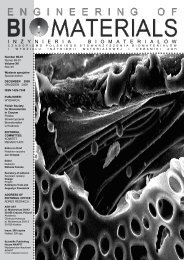62 - Polskie Stowarzyszenie BiomateriaÅów
62 - Polskie Stowarzyszenie BiomateriaÅów
62 - Polskie Stowarzyszenie BiomateriaÅów
You also want an ePaper? Increase the reach of your titles
YUMPU automatically turns print PDFs into web optimized ePapers that Google loves.
9<br />
BAZA WIEDZY<br />
• BAZA DANYCH<br />
• BAZA REGUŁ<br />
KNOWLEDGE BASE<br />
• DATA BASE<br />
• RULE BASE<br />
ROZMYWANIE<br />
FUZZIFICATION<br />
rozmyte wejście<br />
fuzzy input<br />
WNIOSKOWANIE<br />
ROZMYTE<br />
FUZZY REASONING<br />
rozmyte wyjście<br />
fuzzy output<br />
WYOSTRZANIE<br />
DEFUZZIFICATION<br />
Dane w ejściowe<br />
Input data<br />
WYJŚCIE<br />
OUTPUT<br />
RYS. 1. Struktura rozmytego systemu wnioskowania.<br />
FIG. 1. The structure of fuzzy reasoning system.<br />
który używa reguł rozmytych zawartych w bazie wiedzy<br />
w celu określenia rozmytych wniosków, również w postaci<br />
zbiorów rozmytych. Jako wynik procesu wnioskowania<br />
rozmytego, moduł wyostrzania przekształca wynikowy<br />
zbiór rozmyty w precyzyjne rozwiązanie liczbowe.<br />
Dziedziny zbiorów wejściowych ustalono w oparciu o<br />
dane literaturowe, które zostały przedstawione w TABELI 1,<br />
gdzie zaprezentowano zakresy zmiennych dla temperatury<br />
podłoża i odległości od podłoża (w powłoce) [2]. Zakres<br />
zmienności dla temperatury podłoża wynosi (450 0 C÷750 0 C)<br />
natomiast odległość od podłoża (0÷1000 nm), na podstawie<br />
badań przeprowadzonych przez Blalock’a i in. [2].<br />
Wyjściowe zbiory rozmyte reprezentują rozkład zależności<br />
molowej Ca/P przez przekrój powłoki (0÷28). Dla każdej<br />
zmiennej wejściowej i wyjściowej rozmytej określono<br />
zbiory rozmyte nadając im nazwy lingwistyczne: „bardzo<br />
mały (VS), mały (S), średni (M), duży (L), bardzo duży<br />
(VL)”. Wygenerowano funkcje przynależności dla zbiorów<br />
rozmytych, wykorzystując trójkątną i trapezoidalną postać<br />
Odległość od podłoża Ti<br />
Distance from Ti substrate<br />
[nm]<br />
Stosunek molowy Ca/P<br />
Atomic Ca/P ratio<br />
Temperatura podłoża<br />
Substrate temperature [ 0 C]<br />
450 550 650 750<br />
0 0 0 0 0<br />
200 1.9 2.4 2.4 0<br />
400 1.95 2.7 2.3 16<br />
600 2 2.9 2 16<br />
800 2.2 2.5 4.6 14<br />
1000 - - 4.1 26.3<br />
TABELA 1. Wyniki eksperymentalne opracowane<br />
za pomocą STEM-EDS – średni stosunek molowy<br />
Ca/P dla zbioru określonych wartości temperatur<br />
podłoża przez przekrój powłoki [2].<br />
TABLE 1. Experimental results evaluated by<br />
STEM-EDS – the average atomic Ca/P ratio for<br />
sets substrate temperatures along the HA coatings<br />
thickness [2].<br />
the knowledge base to produce fuzzy conclusions, also in<br />
form of fuzzy sets. As a result of a reasoning process, the<br />
defuzzifi cation unit converts resultant fuzzy set into precise<br />
numerical solution.<br />
Domains of input sets have been established based on<br />
literature data shown in TABLE 1, where variability ranges<br />
for substrate temperatures and distance from Ti substrate<br />
were observed. Variability range for substrate temperature<br />
is (450 0 C÷750 0 C), and distance from the substrate<br />
(0÷1000 nm), based on research conducted by Blalock et<br />
al. [2]. Fuzzy output sets represent the Ca/P ratio distribution<br />
over the thickness of the coating (0÷28). For each<br />
fuzzy input and output variable corresponding fuzzy sets<br />
were established with given linguistic names: “very small<br />
(VS), small (S), medium (M), large (L), very large (VL)”.<br />
Membership functions for fuzzy sets were generated using<br />
triangular and trapezoidal membership function form (FIG.<br />
2) [4]. The rule base for fuzzy reasoning system consists<br />
of 20 rules in form of ‘if-then’ statements presented in<br />
TABLE 2. For example, the rule 1 can be interpreted as<br />
follows: “If substrate temperature is small (S) and distance<br />
from Ti substrate is very small (VS), then atomic ratio Ca/P<br />
is very small (VS)”. For resultant output value Ca/P ratio, the<br />
center of gravity defuzzyfi cation method has been used [4].<br />
Fuzzy variables and rule base have been introduced into<br />
Fuzzy Logic Toolbox in Matlab environment [5].<br />
Results and discussion<br />
FIG. 3 shows the resulting value of the Ca/P ratio 1.71<br />
for a chosen input variables: substrate temperature 663 0 C<br />
and distance from the substrate 102 nm. The atomic Ca/P<br />
ratio distribution is increased with the increasing the substrate<br />
temperature over the thickness of deposited samples<br />
used in the investigation (TABLE 1). Using designed FLC<br />
it is possible to predict Ca/P ratio from the control surface<br />
(FIG. 4) for every combination of input parameters with an<br />
average error of 3% comparing to the results achieved by<br />
microstructure characterization techniques, like transmission<br />
TEM and scanning SEM electron microscopies [2,6].













